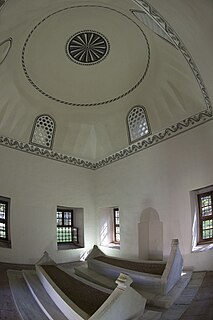 W
WMehmed II, commonly known as Mehmed the Conqueror, was an Ottoman Sultan who ruled from August 1444 to September 1446, and then later from February 1451 to May 1481. In Mehmed II's first reign, he defeated the crusade led by John Hunyadi after the Hungarian incursions into his country broke the conditions of the truce Peace of Szeged. When Mehmed II ascended the throne again in 1451 he strengthened the Ottoman navy and made preparations to attack Constantinople. At the age of 21, he conquered Constantinople and brought an end to the Byzantine Empire.
 W
WAkshamsaddin, was an influential Ottoman religious scholar, poet, and mystic saint. He was an influential tutor and adviser to Sultan Mehmed the Conqueror. After completing his work with his master Shaykh Haji Bayram Wali, he founded the Shamsiyya-Bayramiyya Sufi order. He discovered the lost grave of Abu Ayyub al-Ansari in Constantinople preceding the Siege of Constantinople.
 W
WThe Fatih Sultan Mehmet Bridge, also known as the Second Bosphorus Bridge, is a bridge in Istanbul, Turkey spanning the Bosphorus strait. When completed in 1988, it was the 5th-longest suspension bridge span in the world; today it is the 24th.
 W
WGülbahar Hatun, also known as Mükrime Hatun, was the first wife of Sultan Mehmed II, and Valide Sultan to their son, Sultan Bayezid II.
 W
WGülşah Hatun was a consort of Sultan Mehmed the Conqueror of the Ottoman Empire.
 W
WThe Ottoman invasion of Otranto occurred between 1480 and 1481 at the Italian city of Otranto in Apulia, southern Italy. Forces of the Ottoman Empire invaded and laid siege to the city and its citadel. According to a traditional account, more than 800 inhabitants were beheaded after the city was captured. The Martyrs of Otranto are still celebrated in Italy. A year later the Ottoman garrison surrendered the city following a siege by Christian forces and the intervention of Papal forces led by the Genoese Paolo Fregoso.
 W
WThe Portrait of Mehmet II is a painting by the Venetian artist Gentile Bellini, depicting the Ottoman sultan, Mehmet the Conqueror. It was painted in 1480 while Bellini was in Constantinople on a diplomatic mission, although. This painting is a record of the significant economic and diplomatic ties that existed between Venice and the Ottoman Empire in the 15th century. After a peace treaty is brokered between the Venetian Republic and the Ottoman Empire, the Sultan Mehmet II decided that he would like a painter to be in his presence and paint for him, this task was placed upon Gentile Bellini.